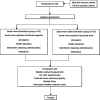Effects of repetitive functional magnetic stimulation in the sacral nerve in patients with neurogenic detrusor overactivity after suprasacral spinal cord injury: a study protocol for a randomized controlled trial
- PMID: 36932375
- PMCID: PMC10022156
- DOI: 10.1186/s13063-023-07207-1
Effects of repetitive functional magnetic stimulation in the sacral nerve in patients with neurogenic detrusor overactivity after suprasacral spinal cord injury: a study protocol for a randomized controlled trial
Abstract
Background: Neurogenic detrusor overactivity (NDO) is a serious and common complication after spinal cord injury, affecting patients' quality of life seriously. Therefore, we developed this research protocol to evaluate the efficacy of repetitive functional magnetic stimulation (rFMS) in the sacral nerve in patients with neurogenic detrusor overactivity (NDO) after suprasacral spinal cord injury (SCI) and provide more options for rFMS in treating NDO after suprasacral SCI.
Methods: This study is a single-center, randomized, parallel-group clinical trial. We will recruit the patients with NDO after suprasacral SCI in the Rehabilitation Department of the Affiliated Hospital of Southwest Medical University from September 2022 to August 2023. They will be assigned to the rFMS group and the sham stimulation group randomly. The sample size is 66, with 33 patients in each group. The rFMS group will receive real rFMS treatment of the sacral nerve (100% stimulation intensity, 5 Hz, 20 min each time, five times a week), and the sham group will receive sham stimulation. Both groups will receive similar treatment strategies, including medication, standard urine management, acupuncture treatment, and health education. The bladder compliance (bladder capacity/detrusor pressure) and pudendal nerve electromyography will be evaluated at baseline, 8th week of treatment. The residual volume of the bladder and bladder diary will be recorded once a week during 8 weeks of treatments. SCI-QOL and NBSS will be evaluated at baseline, the 4th and 8th week of treatment. In addition, the above assessments will be followed up at 8 weeks after the end of treatment.
Discussion: It is expected that the bladder function, symptoms, and quality of life might be significantly improved after rFMS of the sacral nerve.
Trial registration: The China Clinical Trials Registry has approved this study, registration number: ChiCTR2100045148. Registered on April 7, 2021.
Keywords: Bladder function; Neurogenic detrusor overactivity; Physiotherapy; Randomized controlled trial; Repetitive functional magnetic stimulation; Spinal cord injury.
© 2023. The Author(s).
Conflict of interest statement
The authors declare that they have no competing interests.
Similar articles
-
TASCI-transcutaneous tibial nerve stimulation in patients with acute spinal cord injury to prevent neurogenic detrusor overactivity: protocol for a nationwide, randomised, sham-controlled, double-blind clinical trial.BMJ Open. 2020 Aug 13;10(8):e039164. doi: 10.1136/bmjopen-2020-039164. BMJ Open. 2020. PMID: 32792454 Free PMC article.
-
Protocol for a randomized clinical trial investigating early sacral nerve stimulation as an adjunct to standard neurogenic bladder management following acute spinal cord injury.BMC Urol. 2018 Aug 29;18(1):72. doi: 10.1186/s12894-018-0383-y. BMC Urol. 2018. PMID: 30157824 Free PMC article. Clinical Trial.
-
Protocol for a phase II, open-label exploratory study investigating the efficacy of fesoterodine for treatment of adult patients with spinal cord injury suffering from neurogenic detrusor overactivity for amelioration of autonomic dysreflexia.BMJ Open. 2018 Nov 21;8(11):e024084. doi: 10.1136/bmjopen-2018-024084. BMJ Open. 2018. PMID: 30467135 Free PMC article.
-
Meta-analysis of botulinum toxin A detrusor injections in the treatment of neurogenic detrusor overactivity after spinal cord injury.Arch Phys Med Rehabil. 2013 Aug;94(8):1473-81. doi: 10.1016/j.apmr.2013.04.011. Epub 2013 Apr 28. Arch Phys Med Rehabil. 2013. PMID: 23632286 Review.
-
Epidemiology and pathophysiology of neurogenic bladder after spinal cord injury.World J Urol. 2018 Oct;36(10):1517-1527. doi: 10.1007/s00345-018-2301-z. Epub 2018 May 11. World J Urol. 2018. PMID: 29752515 Review.
References
Publication types
MeSH terms
Grants and funding
LinkOut - more resources
Full Text Sources
Medical
Miscellaneous


